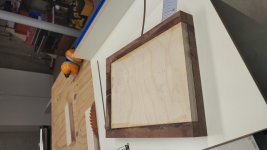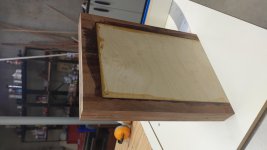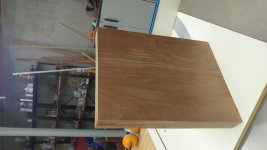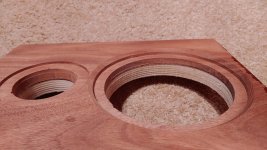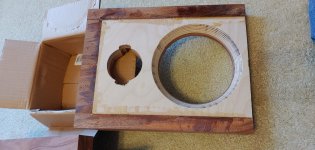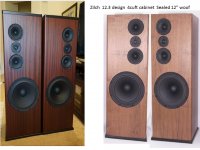I have designed 3way home Hifi speakers
- inner net volume 150l
- 12'' woofer
- BR tuned to 22 Hz
- MTM
- 3 braces vertically (tolal height 1200mm)
- SPL 1W 1m 94db, RPM input power 120W
I would like to make the design similar to CANTON 1.2 DC but with only one woofer.
My idea is:
1. milling solid wood for front baffle 45/25mm hard wood
2a. 22mm MDF otherwise
2b or 20mm MDF + 2.5mm HDF (with some veneer)
It combination of solid wood with MDF (or MDF+HDF) good Idea or
make it completelly from solid hard wood?
Thanks for any suggestions.
Peter.
- inner net volume 150l
- 12'' woofer
- BR tuned to 22 Hz
- MTM
- 3 braces vertically (tolal height 1200mm)
- SPL 1W 1m 94db, RPM input power 120W
I would like to make the design similar to CANTON 1.2 DC but with only one woofer.
My idea is:
1. milling solid wood for front baffle 45/25mm hard wood
2a. 22mm MDF otherwise
2b or 20mm MDF + 2.5mm HDF (with some veneer)
It combination of solid wood with MDF (or MDF+HDF) good Idea or
make it completelly from solid hard wood?
Thanks for any suggestions.
Peter.
I am not sure I understand your 3 options, some sketches might help.
I can offer some thoughts: I recently completed a speaker with what appears to be a solid wood baffle. It is actually a laminated composite of plywood and solid wood.
There is no sonic benefit to a solid wood baffle, it is only done for aesthetics. In my case, with my woodworking skills, it was easier for me to achieve the look I wanted with solid wood. I do not have the veneer skills to veneer a radiused edge to another intersecting radius or beveled edge. Solid wood allowed me to achieve the radiused and beveled edges I was looking for.
My baffle was composed of 19 mm Baltic birch plywood laminated to 19 mm of mahogany. The sides and top edges were also solid mahogany. The plywood was fully encapsulated. I used epoxy to laminate them together.
Solid wood has higher stiffness and strength along its grain than it does across its grain. Therefore to maximize stability and stiffness when working with solid wood, I recommend laminating to plywood. I don't have any experience with MDF or HDF so I don't know if those would work.
Here are the details of my project New active 3-Way, Hypex and SB
I can offer some thoughts: I recently completed a speaker with what appears to be a solid wood baffle. It is actually a laminated composite of plywood and solid wood.
There is no sonic benefit to a solid wood baffle, it is only done for aesthetics. In my case, with my woodworking skills, it was easier for me to achieve the look I wanted with solid wood. I do not have the veneer skills to veneer a radiused edge to another intersecting radius or beveled edge. Solid wood allowed me to achieve the radiused and beveled edges I was looking for.
My baffle was composed of 19 mm Baltic birch plywood laminated to 19 mm of mahogany. The sides and top edges were also solid mahogany. The plywood was fully encapsulated. I used epoxy to laminate them together.
Solid wood has higher stiffness and strength along its grain than it does across its grain. Therefore to maximize stability and stiffness when working with solid wood, I recommend laminating to plywood. I don't have any experience with MDF or HDF so I don't know if those would work.
Here are the details of my project New active 3-Way, Hypex and SB
Attachments
You could certainly improve things by using quality plywood instead of MDF. 15mm would be aprox equivalent in stiffness, 18mm would be what i would recommend for a box that big.
And your back will thank you as well.
Do note the very nice bevel on the backside of the woofer cutout in the last picture Jim posted.
dave
And your back will thank you as well.
Do note the very nice bevel on the backside of the woofer cutout in the last picture Jim posted.
dave
I'm not an expert in woodworking, but as a physicist and viola player I know some things. Even if solid wood is a too generic term, as different kind of wood can have different properties, what is true for all of them is that solid wood will contract and expand with changes is humidity and temperature. So if you glue something that isn't dimensionally stable (solid wood) to something that is (MDF or plywood), the chances to develop cracks in your solid wood baffle are high. Besides that, solid wood will easily resonate, and while this is the desired effect for a musical instrument like my viola, it is an highly undesired effect for a speaker box.
If you paint the speakers what I'd do for a big cab is to use 15/16mm plywood covered with 3mm MDF for all but the baffle, and MDF for the baffle for easy machining. Covering the plywood with thin MDF will create a smooth surface for the paint.
Ralf
If you paint the speakers what I'd do for a big cab is to use 15/16mm plywood covered with 3mm MDF for all but the baffle, and MDF for the baffle for easy machining. Covering the plywood with thin MDF will create a smooth surface for the paint.
Ralf
Only reason to use solid wood for front baffle is aesthetics and easy of processing. I would like to make a side slots (see picture-Canton Reference 1.2 DC). Laminating HDF on MDF (side an top) is just practical. I do not have any experience with veneering and HDFs are available with plenty of patterns.
An externally hosted image should be here but it was not working when we last tested it.
I'm not an expert in woodworking, but as a physicist and viola player I know some things. Even if solid wood is a too generic term, as different kind of wood can have different properties, what is true for all of them is that solid wood will contract and expand with changes is humidity and temperature. So if you glue something that isn't dimensionally stable (solid wood) to something that is (MDF or plywood), the chances to develop cracks in your solid wood baffle are high. Besides that, solid wood will easily resonate, and while this is the desired effect for a musical instrument like my viola, it is an highly undesired effect for a speaker box.
Ralf
It is a little more complicated than that. Wood, like almost every other structural material, can resonate. And this is true whether it is solid timber or plywood. Wooden instruments, such as a viola, must be made of very thin wood and designed very carefully or they will not resonate enough to be musical. Luthiers are among the most skilled of wood workers, and much of their effort is spent in maximizing the resonance of a wood structure. I am sure it is anything but easy.
It is possible to glue solid wood in alternating grain directions in a way which ensures a strong durable structure. Splitting may occur if the composite panel is not designed properly or not restrained properly at the edges.
An example of doing it right: a 1 inch layer of wood, covered on both sides with a 1/2 inch layer of wood with the grain orthogonal to the inner layer. So it is 1/2 inch at 90 degrees, 1 inch at 0 degrees, and 1/2 inch at 90 degrees. This is very stable. it has been used on epoxy laminated boat hulls for years. Splitting is not a problem.
An example of doing it wrong: a 1 inch layer of wood, covered on both sides with a 1/8 inch layer of wood with the grain orthogonal to the inner layer. The two outer layers do not have the stiffness necessary to restrain the center core, and splitting is likely.
So design matters, and any speaker building adventures in solid wood should be undertaken only with a good understanding of how to design with and work with solid wood timber.
Yes, I know I was over simplifying, but wanted to give a quick answer of the big potential problem in using a solid wood for a baffle. And what you are suggesting is not a solid block of wood but in an extreme point of view is some sort of plywood. I suspect that the different layers can be seen, so maybe the OP should better simply use plywood instead.
If HDF is chosen only for the pattern they provide, it can be also glued on plywood.
Ralf
If HDF is chosen only for the pattern they provide, it can be also glued on plywood.
Ralf
I have designed 3way home Hifi speakers
- inner net volume 150l
- 12'' woofer
- BR tuned to 22 Hz
- MTM
- 3 braces vertically (tolal height 1200mm)
- SPL 1W 1m 94db, RPM input power 120W
I would like to make the design similar to CANTON 1.2 DC but with only one woofer.
My idea is:
1. milling solid wood for front baffle 45/25mm hard wood
2a. 22mm MDF otherwise
2b or 20mm MDF + 2.5mm HDF (with some veneer)
It combination of solid wood with MDF (or MDF+HDF) good Idea or
make it completelly from solid hard wood?
Thanks for any suggestions.
Peter.
No, its not a good idea.
At first you should be very clear, which design philosophy you will follow:
-to make the speaker enclosure stiff as granite so that it couldnt vibrate anymore
-or to design a controlled vibration enclosure with real wood.
MDF falls in the first category. To me it sounds dead.
If you want to go the controlled vibration route, this could offer much better results. Or it could be more worse, because it works with energy that is not damped to death and should be killed, the backwarts energy should flow into the speaker enclosure and should do a positive result in vibrating the enclosure.
Thats the principle of every instrument.
Don't mix, its way too complicated and will not give you the results of a real speaker that comes to life with sound fed into it.
Last edited:
My ideas perhaps went wrong but I though:
- thick solid wood does not vibrate as much as thin one, so 45mm front baffle will not colorized the sound (too much), so in this case it behave as dead construction element.
- ideal box should behave as dead construction. Drivers are only elements that should play.
- physical properties (thermal stability in this case) should not be big deal, because living room temperature is considered stable.
- thick solid wood does not vibrate as much as thin one, so 45mm front baffle will not colorized the sound (too much), so in this case it behave as dead construction element.
- ideal box should behave as dead construction. Drivers are only elements that should play.
- physical properties (thermal stability in this case) should not be big deal, because living room temperature is considered stable.
Last edited by a moderator:
If you want to go the dead non resonant route, I'm out here.
Good luck! But my experience with such MDF speakers are: in the end the chassis isn't capable to make those sound colors you dream of. You'll end with a relative dead sounding speaker without the colors you could achieve with a resonant design. Of course this way is much more for the experienced listener and builder. Because the route you want to go is relative simple. For that, you can use thick elements and do inside much damping and wood to make the enclosure stiff. But beware from solid wood. Wood is working every day, there is no dead wood. And it will burst and deform with time and dry out. Thats exact the reason no one has ever build with this material. Use plywood.
I did it all some 30 years ago and since then much water has been flown downside the river Rhine. I use controlled resonant speakers now. Much better, but much more efford to manage to build them in the right way. I use minimal damping only, the same way the old Altec speakers were designed like the famous VOTT. That makes a speaker sing.
Good luck! But my experience with such MDF speakers are: in the end the chassis isn't capable to make those sound colors you dream of. You'll end with a relative dead sounding speaker without the colors you could achieve with a resonant design. Of course this way is much more for the experienced listener and builder. Because the route you want to go is relative simple. For that, you can use thick elements and do inside much damping and wood to make the enclosure stiff. But beware from solid wood. Wood is working every day, there is no dead wood. And it will burst and deform with time and dry out. Thats exact the reason no one has ever build with this material. Use plywood.
I did it all some 30 years ago and since then much water has been flown downside the river Rhine. I use controlled resonant speakers now. Much better, but much more efford to manage to build them in the right way. I use minimal damping only, the same way the old Altec speakers were designed like the famous VOTT. That makes a speaker sing.
Last edited:
Giralfino - It sounds like we are both offering the similar advice to Peter: Yes it is possible to use solid wood timber for a baffle, but it is a more difficult construction. It requires experience in working with solid wood and an understanding of how to take wood expansion/contraction into account when designing the enclosure.
Peter Supe - your concept of what an enclosure should do is correct. It should be acoustically dead. A 45 mm thick baffle is thick enough. But if it is solid wood, all with the same grain direction, it will expand and contract across the grain direction (mostly due to changes in humidity). Because of the thickness, it will not be possible for the rest of the box to constrain the expansion, and there is a risk that the cabinet could come apart over time.
If you use a thin layer of solid wood (5 to 10 mm) over a thick base layer of stable material (plywood or MDF), the much thicker base layer will constrain the expansion/contraction of the thinner solid wood. I would not fear splitting in this case.
In my case, the plywood layer and the solid wood layer are equal thickness. That is the highest thickness of solid wood which I would be comfortable with.
Does this make sense?
My ideas perhaps went wrong but I though:
- thick solid wood does not vibrate as much as thin one, so 45mm front baffle will not colorized the sound (too much), so in this case it behave as dead construction element.
- ideal box should behave as dead construction. Drivers are only elements that should play.
- physical properties (thermal stability in this case) should not be big deal, because living room temperature is considered stable.
Peter Supe - your concept of what an enclosure should do is correct. It should be acoustically dead. A 45 mm thick baffle is thick enough. But if it is solid wood, all with the same grain direction, it will expand and contract across the grain direction (mostly due to changes in humidity). Because of the thickness, it will not be possible for the rest of the box to constrain the expansion, and there is a risk that the cabinet could come apart over time.
If you use a thin layer of solid wood (5 to 10 mm) over a thick base layer of stable material (plywood or MDF), the much thicker base layer will constrain the expansion/contraction of the thinner solid wood. I would not fear splitting in this case.
In my case, the plywood layer and the solid wood layer are equal thickness. That is the highest thickness of solid wood which I would be comfortable with.
Does this make sense?
Peter Supe - your concept of what an enclosure should do is correct. It should be acoustically dead.
No, its not correct. If the concept of a dead enclosure is correct, then all enclosures which enable controlled resonances are wrong.
Do you really think the engineers from Altec, Western Electric, Jensen, Westrex, Audio Note, Goodmans, Klangfilm, RCA and many more reputed companies done all wrong and you'r right on this topic?
Must be a hybris if you think so. You stand on a loosing position. One against all the others.
Peter Supe,
For your MTM, do you plan on using 7" Midranges like the Canton Reference 1.2 DC? Reduce to more common 5" midranges? Zilch build a 12.3 with M=5" which you might review in performance and "appearance".
-----------
Canton Reference 1.2 DC
Specifications
Enclosure type 3½-way Bass reflex system
Frequency Response 18 Hz -40 KHz
Power 500 / 900 watts
Woofer Bass Driver Size (mm) 2 x 12"
Midrange Size mm 2 x 7"
Tweeter 1"
Impedance (Ω) 4-8 ohms
Sensitivity 89.5 db
Subwoofer Size 12"
Product Dimension (H×W×D) 56.3" x 16.5" x 23"
Product Weight 212 lbs
For your MTM, do you plan on using 7" Midranges like the Canton Reference 1.2 DC? Reduce to more common 5" midranges? Zilch build a 12.3 with M=5" which you might review in performance and "appearance".
-----------
Canton Reference 1.2 DC
Specifications
Enclosure type 3½-way Bass reflex system
Frequency Response 18 Hz -40 KHz
Power 500 / 900 watts
Woofer Bass Driver Size (mm) 2 x 12"
Midrange Size mm 2 x 7"
Tweeter 1"
Impedance (Ω) 4-8 ohms
Sensitivity 89.5 db
Subwoofer Size 12"
Product Dimension (H×W×D) 56.3" x 16.5" x 23"
Product Weight 212 lbs
Attachments
No, its not correct. If the concept of a dead enclosure is correct, then all enclosures which enable controlled resonances are wrong.
Well OK... I don't want to get into an argument here. So let me clarify.
Peter Supe - your concept of what an enclosure should do is valid. Most designers today believe an enclosure should be acoustically dead, although there have been many successful designs which incorporated a tailored enclosure resonance as part of the design.
advised panels if wood, according where you want to fix the main resonances : chip wood, OSB panels, ply wood panels - the more layers the better. Anyway, sandwich is always good cause mas-spring-mass behavior. Can be thick though, back of the driver doesn't like stiff break as well.
Bamboo ply seems to be a good trade off over ply wood But better to try high damping polyurethan, as advised by E Gedles
Making a frame old fashion way then glue/sceew panels is still liked by some manufacterers with good result enough (Harbeth, etc)
Bamboo ply seems to be a good trade off over ply wood But better to try high damping polyurethan, as advised by E Gedles
Making a frame old fashion way then glue/sceew panels is still liked by some manufacterers with good result enough (Harbeth, etc)
No, its not correct. If the concept of a dead enclosure is correct, then all enclosures which enable controlled resonances are wrong.
Do you really think the engineers from Altec, Western Electric, Jensen, Westrex, Audio Note, Goodmans, Klangfilm, RCA and many more reputed companies done all wrong and you'r right on this topic?
Must be a hybris if you think so. You stand on a loosing position. One against all the others.
Well OK... I don't want to get into an argument here. So let me clarify.
Peter Supe - your concept of what an enclosure should do is valid. Most designers today believe an enclosure should be acoustically dead, although there have been many successful designs which incorporated a tailored enclosure resonance as part of the design.
Clearly, you are both correct because excellent speakers can be and have been created using both design philosophies. Many companies use MDF and dead enclosures, and many others use tuned resonances in their designs. There are benefits and downsides to both approaches. For the beginner, a dead enclosure is a much easier approach since it is one less sonic factor that needs to be accounted for in the design, and one less thing that can go wrong. For the experienced designer, a resonant enclosure can present an interesting challenge that can have highly desirable results if executed on properly.
Both approaches have been discussed, and it is up to Peter Supe which he prefers to take for his design. Whichever approach he decides to take is correct by definition since both are correct and valid design methods.
Last edited:
I just finished a pair of speakers (Zaph's Seas 2 ways) which appear to have a solid teak baffle, but don't. Solid wood by itself is subject to too much moisture induced expansion & contraction. I took 3/4" MDF (sorry, Dave) and rimmed it with 3/4 x 3/4 teak, on all sides, with mitred corners. I then bonded 1/4" teak (thick veneer in effect) over the teak and MDF layer. I was able to cut a 1/2" chamfer all about the baffle, without fear of exposing the MDF. The only issue you might have is not having access to a handsaw to resaw the hardwood of your choice, or a thickness planer to plane it.
It is interesting topic for discussion...If you want to go the dead non resonant route, I'm out here.
Good luck! But my experience with such MDF speakers are: in the end the chassis isn't capable to make those sound colors you dream of. You'll end with a relative dead sounding speaker without the colors you could achieve with a resonant design. Of course this way is much more for the experienced listener and builder. Because the route you want to go is relative simple. For that, you can use thick elements and do inside much damping and wood to make the enclosure stiff. But beware from solid wood. Wood is working every day, there is no dead wood. And it will burst and deform with time and dry out. Thats exact the reason no one has ever build with this material. Use plywood.
I did it all some 30 years ago and since then much water has been flown downside the river Rhine. I use controlled resonant speakers now. Much better, but much more efford to manage to build them in the right way. I use minimal damping only, the same way the old Altec speakers were designed like the famous VOTT. That makes a speaker sing.
My opinion is that acoustically dead (also means neutral) is much easier starting position. All (almost) you have in your hands.
Resonant enclosure colorizes the sound, that means (perhaps) it not makes sense to choose more expansive low distortion drivers Harmonic distortion equals to colorization...
- Home
- Loudspeakers
- Multi-Way
- Wood combination for 3 way speaker
